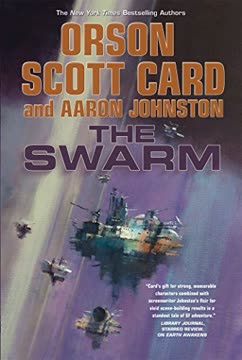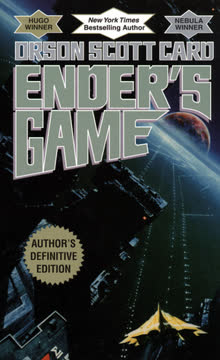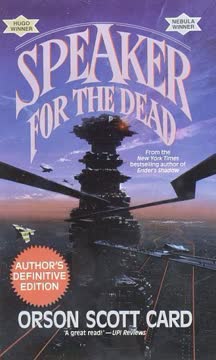Plot Summary
Shadows Over Copernicus
The story opens with the destruction of the Copernicus satellite, humanity's best eye on the approaching Formic fleet. This act, carried out by a lone Formic fighter, shatters the fragile confidence of Earth's International Fleet (IF) and exposes the deep fractures within its command. Mazer Rackham, a seasoned but marginalized officer, is among those who immediately recognize the strategic implications: humanity is now blind, and the enemy is both cunning and technologically superior. The loss of Copernicus is not just a tactical blow but a psychological one, igniting panic, political infighting, and a desperate scramble for new strategies and technologies. The event sets the tone for a war that will be fought as much within the halls of power as in the void of space, with trust and unity in short supply.
Divided Loyalties, Divided Earth
As the IF reels from Copernicus's loss, old national rivalries and bureaucratic sabotage and corruption threaten to paralyze the war effort. China, still traumatized by the devastation of the First Formic War, resists contributing troops, while other nations bicker over resources and command. Bingwen, a child prodigy and war orphan, is thrust into a military system that resents his youth and brilliance. His journey through the labyrinth of military politics and personal danger mirrors the larger struggle: Earth's survival depends on overcoming centuries of mistrust and prejudice. The chapter explores the cost of unity, the pain of being an outsider, and the sacrifices demanded of those who dare to lead when the world is falling apart.
Worms in the Machine
Humanity's assumptions about war and technology are upended as the Formics reveal their true strength: a civilization built on bioengineering as warfare rather than machines. Victor Delgado, a free-miner and reluctant hero, discovers that the Formics are not just invaders but masterful creators, using engineered worms and grubs to mine asteroids and build structures from the inside out. The IF's reliance on mechanical solutions is shown to be a weakness, as the enemy's living tools adapt and multiply in ways no human technology can match. The chapter delves into the awe and terror inspired by the Formics' alien logic, and the dawning realization that victory will require thinking beyond the limits of human tradition.
The Price of Command
Colonel Vaganov, a rising star in the IF, embodies the dangers of self-serving ambition. His alliance with defense contractors and willingness to sacrifice soldiers for personal gain highlight the rot at the heart of the military bureaucracy. Mazer's principled resistance to Vaganov's schemes leads to his isolation and eventual court-martial, a stark reminder that doing the right thing often comes at great personal cost. The chapter explores the tension between duty and self-preservation, the seductive power of authority, and the loneliness of those who refuse to compromise their integrity.
Tunnels of Memory
Bingwen's nightly journeys into the abandoned Formic tunnels become both a literal and metaphorical descent into the enemy's mind. He faces not only simulated Formic attacks but also assassination attempts from within his own ranks, orchestrated by those threatened by his presence. The tunnels are a crucible, forging him into a leader capable of surviving both physical and psychological warfare. The chapter is a meditation on trauma, resilience, and the ways in which the past shapes the warriors of the future.
The Hive Queen's Children
The Formics' greatest secret is revealed: their ability to create new Hive Queens, each capable of commanding her own army. Bingwen's infiltration of an asteroid factory uncovers a nursery where a Hive Queen's daughter is about to be born. In a desperate act, he kills the nascent queen, momentarily disrupting the Formic hive mind and offering a glimpse of hope. Yet the victory is bittersweet, as the true Hive Queen remains at large, and the cost of the mission is measured in trauma and near-death. The chapter explores the alien beauty and horror of Formic society, and the thin line between creation and destruction.
Bureaucracy and Betrayal
The IF's internal divisions reach a breaking point as political maneuvering, corruption, and personal vendettas take precedence over strategy. Lem Jukes, heir to a powerful corporation, navigates the treacherous waters of military contracts, executive infighting, and his father's shadow as Hegemon. The chapter exposes the ways in which greed and ego can sabotage even the most vital cause, and the necessity of finding allies in unexpected places. The struggle for control of technology, information, and command becomes as fierce as any battle with the Formics.
The Asteroid Factories
Victor's exploration of a Formic-occupied asteroid reveals the enemy's true plan: the asteroids are not weapons to be hurled at Earth, but secret shipyards where new Formic warships and armies are being grown. The Formics' mastery of bioengineering as warfare allows them to turn barren rocks into living factories, producing both vessels and soldiers in secret. The IF's realization comes too late to prevent the proliferation of these hidden threats, and the race is on to develop new tactics and technologies before the swarm is unleashed. The chapter is a turning point, shifting the focus from defense to desperate innovation.
NanoCloud and the Unraveling
As the IF scrambles for a way to breach the indestructible Formic hulls, Lem Jukes and Dr. Benyawe lead a team in developing the NanoCloud and molecular unraveling, a swarm of nanobots designed to unravel the enemy's molecular defenses. The project is fraught with setbacks, doubts, and the ever-present threat of sabotage from within. Wila, a Buddhist biochemist, provides the key insight: the Formics' technology is woven, not built, and must be unwoven at the molecular level. The successful test of the NanoCloud is a rare moment of triumph, but it comes with the sobering knowledge that the war is far from over, and that every victory is built on the edge of disaster.
The Battle Room Awakens
Mazer and Bingwen oversee the creation of the Battle Room, a zero-gravity training arena where marines and cadets learn to fight in three dimensions. The Battle Room becomes the heart of the ship, a place where camaraderie, rivalry, and innovation flourish. The young soldiers, many of them orphans and outcasts, find purpose and belonging in the crucible of simulated combat. The chapter is a celebration of adaptability, teamwork, and the indomitable spirit of youth, even as it foreshadows the real battles to come.
Sacrifice and Survival
The war's toll is measured not just in casualties but in broken families, lost innocence, and the sacrifices demanded of every character. Mazer's court-martial and separation from his wife Kim, Imala's pregnancy and forced separation from Victor, and the conscription of children like Bingwen all underscore the personal price of survival. The chapter is a meditation on love, duty, and the ways in which war reshapes every relationship, leaving scars that may never heal.
The Queen's Gambit
The mission to Castalia culminates in Bingwen's assassination of the Hive Queen's daughter, a bold move that disrupts the Formic command structure but also reveals the enemy's capacity for adaptation. The Formics' hive mind is momentarily shattered, but the true queen remains, and the threat is undiminished. The chapter explores the ethics of preemptive violence, the unpredictability of war, and the realization that every gambit comes with unforeseen consequences.
The Cost of Victory
The IF's successes are tainted by the methods used to achieve them: the exploitation of child soldiers, the suppression of dissent, and the willingness to sacrifice the few for the many. Mazer and Bingwen grapple with the moral ambiguity of their roles, questioning whether victory is worth the price. The chapter is a reckoning, forcing characters and readers alike to confront the true meaning of heroism and the limits of justification in war.
The Children's War
The war becomes increasingly a children's war, with Bingwen and his cadets at the forefront of the most dangerous missions. Their ingenuity, courage, and adaptability are humanity's greatest assets, but their exploitation is a source of shame and sorrow. The chapter is both a tribute to the resilience of youth and a condemnation of the systems that force them into harm's way. The future of humanity rests on the shoulders of those least prepared to bear it.
Love in the Void
Amidst the chaos and violence, love persists: between Mazer and Kim, Victor and Imala, and among the makeshift families formed by war. Letters, messages, and the ansible provide solace and motivation, reminding the characters of what they are fighting for. The chapter is a testament to the power of human connection, even when the void of space and the demands of duty threaten to tear it apart.
The Enemy Within
Not all threats come from the Formics. Pirates, profiteers, and corrupt officials exploit the chaos for personal gain, undermining the war effort and endangering lives. Khalid's crew, masquerading as IF officers, raid supply ships and sow confusion. The chapter exposes the darker side of human nature, the ease with which desperation breeds betrayal, and the constant danger of enemies within the ranks.
The Unseen Hand
Throughout the war, unseen hands—be they the Hive Queen's mind, the machinations of politicians, or the quiet courage of individuals—shape the course of events. The development of the ansible, the secret communications device, and the manipulation of information and command reveal that victory depends as much on what is hidden as what is seen. The chapter is a meditation on fate, agency, and the ripple effects of every decision.
The Future Unwritten
As the first phase of the war ends, the future remains uncertain. The IF has won critical victories but at great cost, and the true test lies ahead. The children of war, the survivors, and the innovators look to the stars with a mixture of hope and dread, knowing that the swarm is not yet defeated. The chapter closes with a sense of possibility: that humanity, for all its flaws, may yet find a way to endure, adapt, and thrive.
Characters
Mazer Rackham
Mazer is a seasoned soldier whose experience and integrity set him apart in a military rife with bureaucracy and self-interest. Haunted by the trauma of the First Formic War and the loss of comrades, he is both a mentor and a rebel, challenging authority when it endangers lives or betrays the mission. His relationship with his wife Kim grounds him, providing both solace and a painful reminder of what is at stake. Mazer's journey is one of sacrifice, resilience, and the constant struggle to do what is right in a world that often punishes such choices. His mentorship of Bingwen and his role in developing new tactics and technologies make him indispensable, even as he is marginalized by those in power.
Bingwen
Bingwen is a twelve-year-old orphan whose intelligence, courage, and adaptability make him both a target and a hero. Forced into command by circumstance and the manipulations of his superiors, he navigates the complexities of war with a maturity beyond his years. Bingwen's psychological journey is marked by trauma, isolation, and the burden of responsibility, but also by moments of ingenuity and compassion. His relationship with Mazer is both filial and collegial, a partnership forged in adversity. Bingwen embodies the tragedy and hope of a generation forced to grow up too soon.
Victor Delgado
Victor is a free-miner whose technical genius and practical experience make him a key asset in the war against the Formics. Torn between his duty to family and the demands of the IF, he is constantly forced to choose between personal happiness and the greater good. Victor's relationship with Imala is a source of strength and vulnerability, and his journey is one of self-discovery, sacrifice, and the relentless pursuit of solutions in the face of overwhelming odds. His inventions, especially the exosuit and StabBoots, are emblematic of humanity's capacity for adaptation.
Imala Bootstamp
Imala is a former bureaucrat turned IF officer whose intelligence, empathy, and leadership hold her family and crew together. Her journey from reluctant participant to captain is marked by self-doubt, courage, and the constant balancing of personal and collective needs. Imala's pregnancy and separation from Victor add layers of emotional complexity, highlighting the costs of war on women and families. Her ability to negotiate, adapt, and inspire loyalty makes her a linchpin in the struggle for survival.
Lem Jukes
Lem is the son of the Hegemon and CEO of Juke Limited, caught between the demands of business, family, and the war effort. His journey is one of maturation, as he learns to navigate the treacherous waters of corporate politics, military contracts, and personal ambition. Lem's partnership with Dr. Benyawe and his support for the NanoCloud project are crucial to humanity's technological advancement. His relationship with his father is fraught with rivalry, respect, and the burden of legacy.
Dr. Noloa Benyawe
Benyawe is the driving force behind the NanoCloud project, a brilliant and uncompromising scientist whose dedication to innovation is matched only by her ethical rigor. She serves as a mentor to Lem and a bridge between the worlds of science and strategy. Benyawe's psychological depth is revealed in her moments of doubt, her fierce advocacy for her team, and her willingness to challenge authority when necessary.
Wila Saowaluk
Wila's unique perspective—combining faith, science, and empathy—allows her to see the Formics not just as enemies but as a civilization with its own logic and beauty. Her insights into the Hive Queen's bioengineering and the nature of philotic connections are instrumental in developing new strategies. Wila's journey is one of reconciliation: between science and faith, compassion and survival, and the search for meaning in the midst of destruction.
Colonel Vaganov
Vaganov is a master manipulator whose pursuit of power and personal gain undermines the war effort and endangers lives. His alliances with defense contractors and willingness to sacrifice subordinates for advancement make him a symbol of the IF's internal rot. Vaganov's psychological profile is marked by insecurity, cunning, and a relentless drive to control outcomes, regardless of the cost to others.
Arjuna
Arjuna is the Somali captain of the Gagak, whose primary concern is the safety and well-being of his extended family. His journey is one of adaptation, as he is forced to cede control to Imala and the IF, and to trust in the abilities of others. Arjuna's pragmatism, wisdom, and quiet strength make him a stabilizing force amid chaos.
Khalid
Khalid is a Somali pirate whose raids on IF supply ships and exploitation of chaos reveal the dangers of human frailty and greed. His psychological complexity lies in his self-justification, his manipulation of loyalty, and his capacity for both brutality and reflection. Khalid serves as a reminder that not all threats come from without, and that the line between survival and savagery is perilously thin.
Plot Devices
Bioengineering as Warfare
The central plot device is the Formics' use of bioengineering—worms, grubs, and Hive Queens—to mine, build, and command. This device not only sets the Formics apart as an alien threat but also forces humanity to rethink its reliance on machines and adapt to a new paradigm of war. The biological factories hidden within asteroids, the creation of new Hive Queens, and the use of living weapons all serve to heighten the sense of otherness and the stakes of the conflict.
Bureaucratic Sabotage and Corruption
The narrative structure is driven by the constant tension between those who seek to do what is right (Mazer, Bingwen, Victor) and those who prioritize personal gain or national interest (Vaganov, various politicians). Foreshadowing is used to show how small acts of self-interest can have catastrophic consequences, and how the true enemy is often within.
The Battle Room and Training Simulations
The Battle Room serves as both a literal and symbolic space where new tactics are forged, and where the next generation of warriors is shaped. The use of simulations, training exercises, and evolving technology (StabBoots, nanoshields) allows for rapid adaptation and the testing of ideas in a controlled environment, foreshadowing the real battles to come.
The NanoCloud and Molecular Unraveling
The development of the NanoCloud—a swarm of nanobots designed to unravel the Formic hull at the molecular level—is both a plot device and a metaphor for the need to unweave old assumptions and build new connections. The narrative structure uses the setbacks and breakthroughs of the NanoCloud project to mirror the larger struggle: progress is possible, but only through risk, collaboration, and the willingness to question everything.
Letters, Messages, and the Ansible
The use of letters, e-mails, and the ansible (instantaneous communication device) is a recurring device that connects characters across vast distances, reveals inner thoughts, and drives the plot forward. The secrecy, censorship, and manipulation of information are central to the story's tension, highlighting the power of words and the dangers of silence.
Analysis
The Swarm is a sweeping, multi-perspective narrative that explores the existential threat of alien invasion not just as a battle of weapons, but as a test of humanity's capacity for unity, innovation, and moral courage. The novel's central lesson is that survival depends on the willingness to adapt—not just technologically, but socially and psychologically. The Formics' bioengineering is both a literal and symbolic challenge: to defeat them, humanity must unlearn old habits, embrace new ways of thinking, and find strength in diversity and collaboration. The story is unflinching in its portrayal of the costs of war: the exploitation of children, the corruption of institutions, the pain of separation, and the ever-present danger of losing one's soul in the pursuit of victory. Yet it is also a testament to resilience, love, and the power of individuals to make a difference, even when the odds seem insurmountable. In a world where the enemy is both without and within, The Swarm asks: What are we willing to become to survive, and what must we refuse to become, no matter the cost?
Last updated:
Review Summary
The Swarm receives mixed reviews, with an average rating of 4.14/5. Many praise its complex plot and character development, particularly for fans of the Enderverse. Some find it a slow-paced setup for the trilogy, lacking action. Readers appreciate the exploration of political and military challenges, but note continuity issues with previous books. The novel is seen as a solid addition to the series, though some feel it drags and relies heavily on prior knowledge. Overall, it's considered enjoyable for dedicated fans but may not stand well on its own.
Download PDF
Download EPUB
.epub digital book format is ideal for reading ebooks on phones, tablets, and e-readers.









